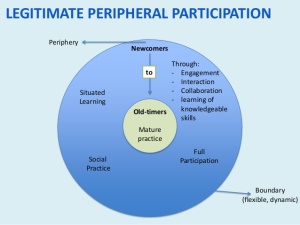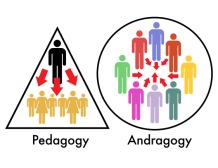 Participation in a post-mortem is always so much more enjoyable when done in a group setting. Couple the discussion with a liquid libation and the conversation really begins to flow. As I am doing this reflection sans either of the above, it may be a little bit dry. I will, however, be brief. I tend to be rather wordy, which may cause readers to disconnect with the content.
Participation in a post-mortem is always so much more enjoyable when done in a group setting. Couple the discussion with a liquid libation and the conversation really begins to flow. As I am doing this reflection sans either of the above, it may be a little bit dry. I will, however, be brief. I tend to be rather wordy, which may cause readers to disconnect with the content.
Historical and conceptual foundations of eLearning: 
I look back at several of the blog entries written at the beginning of this course of study. Several salient ideas from my blogs are:
(Links to previous blogs are linked with ideas.)
- Moore’s Theory of transactional distance makes the operator’s ability to offer instruction transportable. When coupled with the ever-changing world of technology and tools, the possibilities are endless.
- Several ideas from the discussion of connectivism pulled from the TedX talk were bulleted by me:
“The act of showing others how we are learning is an instructional task.” (11:14)
“Every expression is an opportunity for connection in a digital space.” (11:23)
“Problems can’t be solved by an individual. They can be solved by a network.” (14:16)
- My thinking was pushed in when considering constructivism and how it applies to the learning and teaching for this course. I considered:
- Understanding how to apply adult learning theories, particularly constructivism, may have been in need of discussion. I would be interested in learning if this researcher has refined the ideas suggested in her work. When planning for learning in this model, I was mindful of what might be of interest to an individual who instructs adults.
When considering Identify design elements, instructor and student roles, community building strategies, and the role of feedback and assessment in creating online learning experiences.
- I found the learning in terms of content and resources to be energizing which forced me to stretch my thinking.
- There was relatively little community engagement from my perspective, which I found rather disappointing. Feedback was inconsistent and often not helpful for me as a learning. On most occasions, I pushed myself to include a “Something to Chew on” where I hope to extend the conversation and engage in thinking and conversation with classmates. This did not occur.
Activities- in terms of most and least effective in achieving my goals:
- Reading-the reading for this course was stimulating. I appreciate being pushed to consider topics that were not necessarily covered in other courses.
- A Feedly account was not as beneficial to me as I thought it might be. I find that several individuals whom I consider as vital to my PLN (Professional Learning Network) are the best ways in which to stay abreast of what’s new.
- I “follow” adult learning and as a result, receive timely articles on my phone nearly every day.
- Twitter is useless for those who are not committed to using it for learning purposes. When individuals tweet 1-2 times a semester, it’s not a useful tool for them. What makes it work for me is the fact that I “unfollowed” everything not related to learning and education. Prior to doing this, I found that Twitter was just too much noise.
- Virtual learning intrigues me. Positioning it to the beginning of the course may have provided motivation to explore it more fully for use in my module. I can see the value of it in designing learning for my students outside of the module and am excited about how it may influence my practice.
Looking ahead to the next rotation of this course-
- Digital tools are a component of my current practice as an educator. I envision that they will continue to support the learning I facilitate, but not replace it. It would be valuable to offer the 641 course, Social Media for Adult Learners, first and this course second, in my opinion. Taking that course early in my Adult Learning graduate program was beneficial to me as a learner. Establishing a Professional Learning Network as well as understanding the environment in which one learns best was instrumental in navigating self-direction.
- The human component of learning is the essence of who I am as an adult. I think that it would support adult learners in this course in a hybrid setting more effectively than in an asynchronous setting. While this is just my opinion, my thoughts are valid. It’s difficult in a digital setting to develop a relationship with a learner, to let them know that you care and wish to help them learn.
While I may not have addressed each of the questions posed as part of the reflection, the twenty-one (21) blogs coupled with the learning module created show evidence of my learning, thinking and questioning. The learning developed through this program will serve me well in the future. Learning in context supports me as I strive to make what I am learning and thinking visible.

I did not begin with the tacit knowledge of how to design learning for digital learners. Through this course of study, I have advanced my learning of digital cultures and e-learning. I am now more able to reflect on the tacit knowledge as it becomes visible in future performance.




 A philosophy of e-learning prior to this course would have evoked a rather flip if not an overtly sarcastic response from me. Engaging young students born in a digitally infused world may embrace such tools as fun and engaging. When considering my learning module for older adults, I was not so enthusiastic. “Was-past tense” being the operative word.
A philosophy of e-learning prior to this course would have evoked a rather flip if not an overtly sarcastic response from me. Engaging young students born in a digitally infused world may embrace such tools as fun and engaging. When considering my learning module for older adults, I was not so enthusiastic. “Was-past tense” being the operative word. The table embedded within the article indicates that it was extended to include the qualities of complexity pedagogy. I wonder what Chris Argyris would think of infinitely recursive learning? Triple loop learning is employed by organizations during times of transformation. In order for collective learning to occur, the ways in which individuals contribute to and participate in learning must be agreed upon and upheld by the members of the collective. Too often online learning, in my limited experience, is content dump and regurgitation. If learners show up regularly, contribute consistently, respond with thought-provoking reactions to others the community works. Learning as a collective can work. Notice that I stated “can” as opposed to “will” because all participants do not come to the group with the same skill set and participation ethic. Sorry, but reality does bite. Returning to the concept of Community of Inquiry, participants learn together; a tenant of Complexity Pedagogy. An e-Learning environment is an instance to revisit the concept of how learners learn.
The table embedded within the article indicates that it was extended to include the qualities of complexity pedagogy. I wonder what Chris Argyris would think of infinitely recursive learning? Triple loop learning is employed by organizations during times of transformation. In order for collective learning to occur, the ways in which individuals contribute to and participate in learning must be agreed upon and upheld by the members of the collective. Too often online learning, in my limited experience, is content dump and regurgitation. If learners show up regularly, contribute consistently, respond with thought-provoking reactions to others the community works. Learning as a collective can work. Notice that I stated “can” as opposed to “will” because all participants do not come to the group with the same skill set and participation ethic. Sorry, but reality does bite. Returning to the concept of Community of Inquiry, participants learn together; a tenant of Complexity Pedagogy. An e-Learning environment is an instance to revisit the concept of how learners learn.
 Module: Please consider the following:
Module: Please consider the following: Self-disclosure time… I am not a technical person. I realize that a component of the TPACK lesson was the discussion of my role in terms of the technical components. This is a weak area for me. I am entirely self-taught, which may be self-evident when looking at the site. I value digital learning and consider myself to be a digital resident. It’s the first place I go for information. I would work best in an educational setting where I did the research and handed it over to someone else.
Self-disclosure time… I am not a technical person. I realize that a component of the TPACK lesson was the discussion of my role in terms of the technical components. This is a weak area for me. I am entirely self-taught, which may be self-evident when looking at the site. I value digital learning and consider myself to be a digital resident. It’s the first place I go for information. I would work best in an educational setting where I did the research and handed it over to someone else.


 Adults may be completely self-directed in every aspect of their lives. When they enter an environment labeled, “education,” many sit back, cross their arms and ask to be taught. How have you approached adults in this setting? Which tools do you have in your arsenal to soften the stronghold of previous learning? How could these ideas transfer to my e-learning module?
Adults may be completely self-directed in every aspect of their lives. When they enter an environment labeled, “education,” many sit back, cross their arms and ask to be taught. How have you approached adults in this setting? Which tools do you have in your arsenal to soften the stronghold of previous learning? How could these ideas transfer to my e-learning module?

